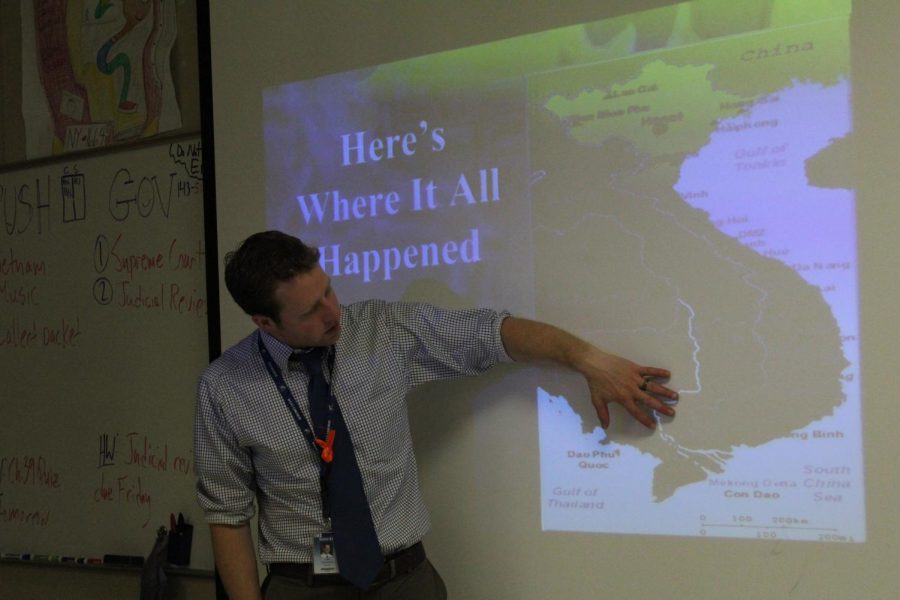The 5Ws and more for upcoming AP tests
Photo by Mayeli Vivaldo
AP (Advanced Placement) U.S. history John Chisholm gives a Vietnam War presentation, a topic touched upon in the AP U.S. history test.
May 1, 2018
Starting from Monday to May 18, 429 students will take a, if not more than one, Advanced Placement (AP) test after nearly a year of studying for it.
According to Assistant Principal Allister Scott, 76 freshmen, 87 sophomores, 140 juniors, and 126 seniors have signed up for AP testing.
This year, students had to pay $100 for each exam they signed up for. Students who qualified or have reduced or free lunch only had to pay $20 for each exam.
The tests, organized by College Board, are exams that can potentially give students college credit if their scores meet college requirements.
In order for students to take the exams, they must sign up for AP classes. AP classes are taught, according to College Board, very similar to college courses in difficulty and pace.
The school offers 21 out of the 38 tests offered by College Board: Spanish literature, Spanish language, Physics 1, English literature, Physics 2, United States government and politics, environmental science, German language, computer science principles, U.S. history, biology, physics C: mechanics, physics C: E&M, music theory, calculus AB and calculus BC, English language, macroeconomics and microeconomics, world history, statistics, and human geography.
The format for the majority of the tests is similar.
“Most of the tests have two sections, a multiple choice section, and a written response section,” Scott said. “Tests last typically three hours, about an hour and a half for multiple choice and an hour and a half for the written response.”
Because AP exams cover an entire year’s worth of lessons, they can be difficult.
“(Students in the past) struggled with not understanding the difference between a high school test and an AP test. Many students take a high school test and expect to get a 70 or 100 percent,” Scott said. “There’s an expectation that they’re going to do very well on that test. AP tests are not designed that way. Students don’t realize how difficult the tests are.”
AP tests, rather than a percentage or a letter grade, are scored based off a number from zero to five, zero being the lowest score.
Although the tests are quite difficult, students can still reach a high score.
“You can feel like you have not done well but still get a three, four, or five on the test,” Scott said. “They don’t need to do as well as they think they need to do on the test (to get a high score).”
The criteria for how the tests are graded and what is asked for from students vary from subject to subject.
Three AP teachers offered advice to students.
AP Spanish language
Fifty-five students signed up for the Spanish language test on May 8 at 7:45 a.m.
Students will have to read, write, speak, and listen for the test.
“They are going to have to do critical reading for a variety of texts, answer questions such as ‘what’s the general purpose of this article?’ They have to participate in a conversation that’s recorded, and give a two-minute speech on cultural comparison,” Spanish language teacher Beth Govertsen said. “They have to respond to an email and write a persuasive essay that integrates an article, an audio, and a graphic. It’s a marathon.”
The exam is testing students’ critical thinking and reading abilities while encouraging cultural awareness.
“I think they are trying to get kids to understand cultural differences and similarities. Critical reading and thinking are trying to expand your horizons and personal borders,” Govertsen said.
According to Govertsen, an extensive vocabulary is very important for a successful test.
“You can’t do anything unless you amplify your vocabulary. We put together Quizlet lists this year. That’s the foundation for everything that we do,” Govertsen said.
Students are required to complete various tasks for the test, but regardless, Govertsen believes the formats given to students makes the test easier, especially for the writing components.
“I think the specific structures can limit you, but also free you because on the day of the test you’re not going to be (thinking), ‘how am I going to structure this essay?’” Govertsen said. “ You know what the structure is going to be so that opens up a little bit of time for you to express your individual thought.”
The biggest struggle Govertsen has seen students face is the reading and multiple choice part of the test.
“The students here have a really good control over their speaking and their writing but AP tries to make the questions really tricky, so one little, tiny nuance can really change the meaning of an entire sentence,” Govertsen said. “They also have two answers on the multiple choice that are correct and you have to decide which is more correct. That’s tough.”
Govertsen recommends that students focus on the author’s purpose in order to overcome this struggle.
“Sometimes it’s the more overarching response and sometimes it’s the more exact response. You really have to think about the author’s purpose. What does the author want you to understand here?” Govertsen said.
For the speaking and recording part of the test, Govertsen also recommends that students slow down rather than rush.
“Everyone always feels panicked and speaks too quickly. It all comes down to the quality of the content that you’re talking about. It’s all based on the content,” Govertsen said.
Lastly, Govertsen assures students that they are more than ready for the exam.
“I think what we have covered has always been a little bit more difficult than the test itself. They should be in top physical, mental shape to take this test,” Govertsen said. “They will be at a level that is more advanced than the AP test is asking them to perform at.”
The vast majority, according to Govertsen, do get credit for this test.
U.S. history
Seventy-three students signed up for the U.S. history test on May 11 at 7:45 a.m.
There are two parts to the U.S. history test. There will be 55 multiple choice questions along with three short answer questions for the first part of the test. The second part consists of writing essays and analyzing several documents.
“The questions will have some sort of stimulus. It’s going to be a political cartoon, a short poem, a short speech and they have to interpret that document and answer two or three questions based on that document,” U.S. history teacher John Chisholm said. “Part two is very heavy duty. They’re giving them 100 minutes and in that time they have to answer a DBQ (Document Based Question). They’re asked a question and they’re given a series of documents that they have to use as evidence, kind of like research questions.”
The AP test is not only testing for memorization, but it’s looking at students’ abilities to apply what they know.
“Prior to 2015, it was basically, who can memorize the most amount of historical facts. Now, there’s more of an emphasis on skills as opposed to just memorization,” Chisholm said. “They’re looking for the kids to be able to apply what they know. So yes, you might be able to memorize all these facts, but do you know how to organize them into a coherent essay?”
It is this, according to Chisholm, that students struggle with the most during the AP tests.
“My AP kids will memorize facts and get a 100 percent on a quiz, but give them a question that they haven’t seen before where they have to critically think, they struggle with that and panic. The writing is what holds them back,” Chisholm said. “So how does a kid not score a five? It’s the writing.”
In order to improve on this, Chisholm recommends that students organize their thoughts before writing.
“It helps to use graphic organizers to set up your argument. Think through what you’re going to answer, don’t just jump into it,” Chisholm said. “It might take you five or 10 minutes, but it’s well worth your time to do that.”
According to College Board, only 10.8 percent of test takers scored a five on the 2017 U.S. history AP test.
Regardless, Chisholm doesn’t believe the test is very difficult.
“I think if you’ve studied U.S. history and you can critically think, if you do the work, you should have a good chance to pass this test,” Chisholm said. “I would say AP world geography is harder to pass.”
Most importantly, Chisholm highly recommends that students get a good night’s sleep before the test and a breakfast.
“Go to bed at 9 0’clock, get a lot of sleep, don’t stay up at 2 in the morning reviewing, it’s not going to do you any good. Studies tell you after 9 or 10 o’clock at night, your mental capacities are significantly diminished,” Chisholm said. “Eat a big breakfast so that you have energy.”
English language
Seventy-two students signed up for the AP English language test on May 16 at 7:45 a.m.
The test is composed of two parts as well, a multiple choice part and a writing part consisting of three essays.
“The multiple choice is essentially an hour. Then they have two hours and 15 minutes for the essays,” AP English language teacher Brian Turnbaugh said. “The first one is a synthesis essay, the second is a rhetorical analysis, and the third one is a sort of open-ended question. It’s asking to comment upon an idea (or) quote.”
Turnbaugh believes the test is, in its own way, more difficult than most AP tests because it focuses mostly on the skills students have rather than memorization.
“With the exception of some vocabulary that you can learn, it’s skills. Have you been doing diligence of thinking more clearly and making sure that you’re finding the best expressions, honing your craft as a writer and thinker?” Turnbaugh said. “As opposed to more content driven AP classes, that’s why this one is a bit more difficult to get our hands around.”
According to Turnbaugh, although the multiple choice section of the test is the most difficult due to its randomness, he believes students can still prepare for it.
“The metaphor I use frequently with my students, it’s a boxing metaphor, for the multiple choice section is you don’t know who is going to show up, but you do know that they only have certain types of punches they can throw at you,” Turnbaugh said. “There are going to be questions about tone, strategy, and other types of rhetorical structure questions.”
Students, throughout the years, have struggled the most with time management on the test.
“There are a lot of nerves and sometimes they are not aware that maybe they spent more time writing the synthesis essay and now all the sudden they only have 45 minutes to write the other two essays,” Turnbaugh said. “There’s a lot going on that you have to be mindful of keeping a pace and I think that gets lost with students.”
To avoid this problem, Turnbaugh suggests that students look at the clock often and keep a steady pace throughout the test.






